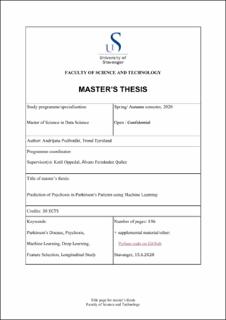| dc.contributor.advisor | Oppedal, Ketil | |
| dc.contributor.advisor | Fernández Quílez, Álvaro | |
| dc.contributor.author | Podhraški, Andrijana | |
| dc.contributor.author | Tjersland, Trond | |
| dc.date.accessioned | 2020-09-28T10:20:44Z | |
| dc.date.available | 2020-09-28T10:20:44Z | |
| dc.date.issued | 2020 | |
| dc.identifier.uri | https://hdl.handle.net/11250/2679928 | |
| dc.description | Master's thesis in Computer science | en_US |
| dc.description.abstract | Parkinson’s disease is one of the most common neurological disorders with an estimated 6.3 million PD patients worldwide, which makes it a great threat to public health. Psychosis is a common symptom of Parkinson’s disease and over half of patients with PD develop symptoms of psychosis over the course of their disease. PD patients who develop such symptoms have greater rates of cognitive decline and progression to dementia. It is important to detect patients that will eventually develop psychosis as early as possible, so that appropriate treatment can be started and negative effects can be reduced for both patient and caretakers.
Early detection of psychosis in PD patients is a difficult task from a clinical viewpoint. This project therefore aimed to develop various ML models, on a subset of data collected by the Parkinson’s Progression Markers Initiative (PPMI), to predict psychosis in PD patients. We selected features from the PPMI database that are more easily collected and therefore more available. Examples include clinical tests, questionnaires and demographic data, but not for example brain imaging scans or biological samples such as cerebrospinal fluid. This makes our models applicable on a wide range of PD patients. We developed a preprocessing pipeline for the selected features and three different prediction approaches: using baseline data, derived longitudinal statistics and deep learning. The latter two approaches benefit from the temporal nature of the data from the PPMI study.
The derived statistics approach gave us the best results. It was followed by the baseline approach, while the deep learning approach came last. Support vector machines and logistic regression were our best performing models. Among tree based models, random forest showed the best performance. The deep learning approach made use of a long short-term memory (LSTM) network, but did not produce the best results. | en_US |
| dc.language.iso | eng | en_US |
| dc.publisher | University of Stavanger, Norway | en_US |
| dc.relation.ispartofseries | Masteroppgave/UIS-TN-IDE/2020; | |
| dc.rights | Navngivelse 4.0 Internasjonal | * |
| dc.rights.uri | http://creativecommons.org/licenses/by/4.0/deed.no | * |
| dc.subject | informasjonsteknologi | en_US |
| dc.subject | datatekknikk | en_US |
| dc.subject | parkinson's disease | en_US |
| dc.subject | psychosis | en_US |
| dc.subject | machine learning | en_US |
| dc.subject | deep learning | en_US |
| dc.subject | feature selection | en_US |
| dc.subject | longitudinal study | en_US |
| dc.title | Prediction of Psychosis in Parkinson’s Patients using Machine Learning | en_US |
| dc.type | Master thesis | en_US |
| dc.subject.nsi | VDP::Teknologi: 500::Informasjons- og kommunikasjonsteknologi: 550 | en_US |
| dc.subject.nsi | VDP::Teknologi: 500::Medisinsk teknologi: 620 | en_US |

